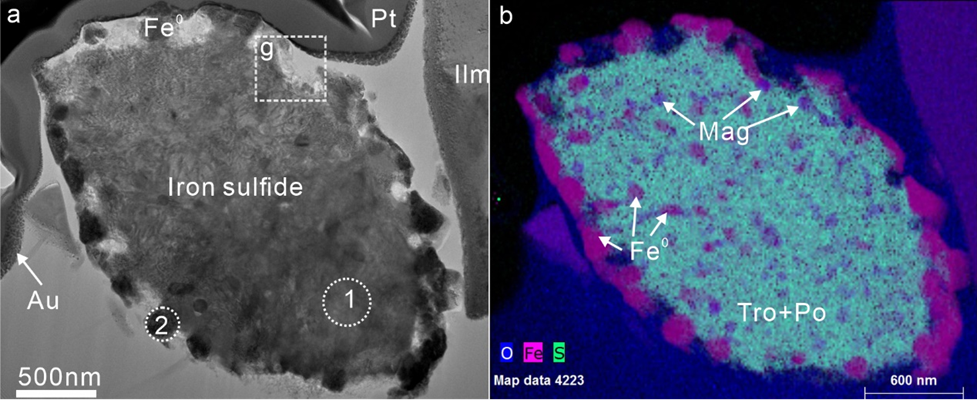A research team led by Prof. LI Yang and Dr. GUO Zhuang from the Institute of Geochemistry of the Chinese Academy of Sciences (IGCAS) conducted in-situ electron microanalysis of spherical iron-sulfide grains in the finest Chang'E-5 lunar soil and has confirmed the presence of impact-induced sub-microscopic magnetite.
The study was published in Nature Communications on Nov. 23.
Magnetite is essential in planetary science when addressing questions concerning ancient magnetic fields and indicators of life. Traditionally, the Moon is considered to be extremely reduced. Thus, the oxidation state of the lunar surface points to the formation of metallic iron rather than iron oxides.
In the Apollo era, some studies deduced the presence of ubiquitous sub-microscopic magnetite-like phases in Apollo soils, but there was no further in-situ mineralogical evidence for the presence of widespread magnetite crystals in lunar soils.
In this study, magnetite-bearing spherical iron-sulfide grains (<2 μm in diameter) were observed in the Chang'E-5 lunar soil. Transmission electron microscopy observations indicated that the spherical iron-sulfide grains were characterized by a ring of almost equidistant pure-iron tentacles at the edges of the grains and by the ubiquitous sub-microscopic magnetite and metallic iron particles that precipitated in the internal troilite–pyrrhotite matrix.
Combining these observations with thermodynamic calculations, the researchers found that a gas-melt phase reaction occurred during large-impact events on the Moon, which allowed FeO dissolved into the iron sulfides to produce sub-microscopic magnetite and metallic iron through eutectic reaction (4FeO = Fe3O4 + Fe).
This first discovery of impact-induced sub-microscopic magnetite provides direct evidence that native magnetite may be widely distributed in the finest lunar soil.
Moreover, lunar magnetic anomalies have been a mystery since the Apollo era and their origin is still under debate. Previous studies only established the relationship between large impact ejecta and magnetic anomalies but did not focus on the transformation of material during impact.
"Our study observed another important ferromagnetic mineral (magnetite) formed by eutectic reaction during the impact processes on the Moon," said Prof. LI. "Due to the high magnetic susceptibilities of magnetite and metallic iron, the impact processes would greatly reduce the thickness requirements of lunar soil for lunar magnetic anomalies."
Therefore, impact-induced formation of magnetite in lunar samples also provides experimental verification and theoretical support for the explanation of magnetic anomalies on the Moon.

Spherical iron-sulfide particles containing magnetite in Chang'e-5 lunar soil (Image by IGCAS)
The study was supported by the lunar samples from the CNSA and funded by the Strategic Priority Research Program, CAS; Key Research Program of Frontier Sciences, CAS; National Natural Science Foundation of China; Youth Innovation Promotion Association, CAS, and Technical Advanced Research Project of Civil Space.
Contact:
LI Yang
Institute of Geochemistry, the Chinese Academy of Sciences
E-mail: liyang@mail.gyig.ac.cn
(By Prof. LI Yang's group)